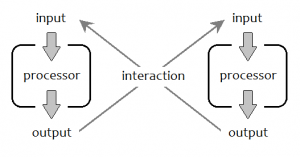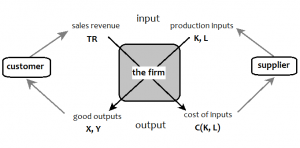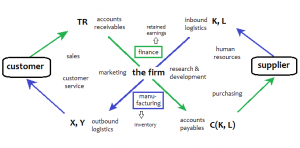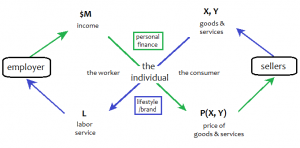Conceptions of utopia are not just for science fiction writers and political philosophers. We can safely infer that visionary leaders in business, government, art, and science all view their work as some sort of advancement or improvement to human civilization, and while they may not explicitly illustrate their vision of a more perfect society, nor identify their contribution as being in context of that vision, they undoubtedly have a vision: some personal notion as to what an ideal society would look like. (The only “visionary” members of society likely to not have some sort of personal notion of utopia would be religious zealots: those who believe that mankind will not progress until some sort of divine event delivers us to some next phase of existence.)
Of course, individual versions of utopia differ vastly, but I’m going to propose here that these are differences in means more than they are differences in ends. For example, Rand and Marx hold what could be called opposite views as to how society should be structured in order to be poised for progress. However, they would agree that the goal of society would be some sort of widespread, highly cooperative brotherhood (with or without money) in which the need for government has all but vanished.
With that in mind, I will outline what I believe would be three commonly agreed upon end goals of society, and the two barriers to achieving those goals.
An hypothesized notion utopian society would likely feature:
1. Zero crime
2. Zero poverty
3. Continual progression towards a) maximum human contentment and b) understanding of the universe
The constraints to achieving these three features are:
1. Humans are self interested organisms, so one party may have an impulse to content itself at a cost to another party.
2. We live in a world of limited resources.
I can think of three forces that have or could have a dramatic effect on crime:
1. Some sort of enlightenment in which the impulse to act selfishly has been conditioned out of us, and there exists a universal agreement on what constitutes “good” and “evil” acts. I put the words “good” and “evil” in quotation marks, because I’m of the belief that the universe itself is neutral; the concept of good and evil are human-evolved constructs. In short, a “good” action increased the overall fitness of the tribe; “evil” decreased the overall fitness of the tribe. Back when human societies did not exceed the size of a tribe, the tribe could effectively provide the social pressure to conform to generally “good” behavior, and it could also judiciously punish or destroy an “evil” person. I don’t think we will ever fully agree on the definitions of good and evil, and there’s too much gray area over what would be in a modern society’s best interests.
2. A fear of eternal damnation for one’s “evil” acts. This is, of course, the method of crime-control employed by the Abrahamic religions (and some Indian religions as well). I have to say that intellectuals are so often vexed by religion’s history of brainwashing and violence that they miss something big: many people are too simple-minded to know what ethical behavior is, so they may need the threat of eternal damnation to keep them from killing their ex-boyfriend. The tricky part with religiously defined “good” and “evil” is that it can easily lead to “we of this religion represent absolute good an you the infidels represent absolute bad; therefore we are correct in destroying you.”
3. Appropriate consequences for those who act recklessly or aggressively towards others. There would have to be some sort of system or even institution in place to accomplish this. If we apply the non-aggression principle as a guide, we can do our best to make sure that institutions within society avoid a similar problem of absolute “good” and “evil.” In other words, we should hesitate to give one single institution (a government) a monopoly over deciding (a) what is “evil,” (b) identifying the parties who committed this “evil,” and (c) carrying out the judgment for committing the “evil.” Such an institution will evolve to believe that it represents all that is “good” in the world, and that it is incapable of “evil,” and that all who oppose it are themselves “evil.” What an institution defines as a crime is a likely factor as well, and this is the point at which social libertarians will advocate the legalization of “victimless crimes,” such as drug usage and sales, gambling, and prostitution.
All three of these already help control crime to some capacity, and it’s unlikely that any will trump any other in a future society, nor will any become obsolete. Some of us simply don’t want to wrong others out of empathy, others of us fear a deity, and yet others fear terrestrial judgment from man-made institutions. A true utopia may perfect all three of these in such a way that crime becomes obsolete.
On the question of zero poverty:
Poverty may be highly relative: what’s considered poverty in the United States may pass as a middle class standard of living in another country. Utopias usually involve the elimination of poverty, implying that everyone at least has the opportunity to have basic needs: a house, some opportunity for employment, food, and access to educational facilities to better oneself. By this definition, poverty is a minimal issue in the US, but the rhetoric of what constitutes poverty continuously changes as the standard of living increases for the upper and middle classes.
A quick comment on the connection of crime and poverty belongs here. Perhaps we believe on some level that theoretically, the elimination of poverty should itself eliminate crime, because if the bottom rung of society were at least “content,” it would therefore not be motivated to commit crime. I don’t believe this would ever be the case. Humans will always be jealous of each other; crime will obviously exist so long as there is inequality.
Poverty may not only be relative; I believe it’s deplorability is also dependent on the self-esteem of the impoverished individual. In other words, poverty is a state of mind. Someone extremely close to me grew up in poverty in a developing country, but she recalls those chapters in her life with nostalgia, not the shame and discomfort Americans usually have when they speak of abject poverty. For her, bathing in a river and cooking with fire was fun. Her family built the house in which she lived, and they kept it clean. She regards her past life as not necessarily “worse,” than her life now in the US as much as it was “different.”
I contrast her experience to that of impoverished people in the United States: their obesity, their government checks, their satellite and cable TV, their cars, their filthy living quarters which are often cluttered with stuff they still manage to buy thanks to Keynesian Economics. We often misdiagnose our disgust for their lifestyle as disgust for the existence of poverty. It’s not that they’re impoverished; most poor people in the US are not lacking material things; they’re lacking pride.
So the question of poverty may really be a question of how far we should go in trying to eliminate inequality of outcome, (or rehabilitate the poor). If society is to advance, then it must be free in the sense of allowing appropriate compensation for one’s productive contributions and innovations. If we are to have economic freedom, then we must tolerate at least some degree of inequality, else we condone and create incentive for non-productivity and non-innovation, and society will not advance.
Marx believed that the relationship between a slave and an owner (or between a worker and a capitalist) was inherently unstable, because the slave was creating all the value, and the owner was absorbing the majority of that value. Such a relationship could only last for so long before the slave was able to leverage a more balanced relationship. This is called dialectic materialism, and though Marx never used that phrase himself, it sums up the idea that underlies his narrative of the history of man.
Within dialectic materialism is Marx’s tragic miscalculation: if some poor people within a society are permitted to not work, yet maintain the purchasing power of those who do work (as is the case in a welfare state), then the worker is still the slave; his new master is the poor non-worker. It’s hard to accept that this would have any consequence other than lowering the morale and productivity of the working class, which will likewise stifle society’s ability to advance.
So poverty will only be eliminated in a progressive society if poor individuals are constantly empowered to maintain a lifestyle that doesn’t make the middle and upper classes feel as though they have failed the poor. No matter what a society looks like, there will always be a bottom ten or twenty percent, and at least some but probably many of those individuals will feel as though the rest of society is responsible for their situation. If those feelings are what actually leads to poor self-esteem and a deplorable lifestyle, an “impoverished” section society will therefore always have to exist if we wish to have a society that can progress.
On continual progression:
Even more than zero crime or zero poverty, most may envision the road to utopia as advancing towards a more complete understanding of our universe via science and towards maximum human contentment via technology.
In the sciences, advances in thought are frequently the product of individual insight compounded on top of a body of prevailing theories, like with Einsteins theory of Special Relativity, Gregor Mendel’s early work that lead to genetics, Mendeleev’s publication of the Periodic Table, or the work of Paul Erdos, just to name a few. Sometimes, they are the product of team efforts, such as the discovery of the Higgs-Boson particle or the mapping of the human genome. Such discoveries and advances in thought not only help us understand the universe, they also lay a foundation upon which advances in technology and medicine may be made, improving the human condition.
Advances in technology and medicine are similarly dependent on teamwork, but often with the insight and leadership of a visionary leader. When Karl Benz developed the internal combustion engine, the possibility of an affordable and less-polluting mode of transportation was born. When Henry Ford developed an assembly line for the production of automobiles, he crystallized Benz’s concept: the masses could afford a personal carriage that enabled transportation in a way that was previously only available to wealthy elites. I see the efforts of Steve Jobs in a similar manner: he did not invent the cell phone, nor the concept of a personal computer, nor even a personal music player, nor even the concept of combining those objects into one technology. What he did do was permanently and dramatically raise our expectations for personal devices. It suffices to say that a society poised to advance must therefore convince an innovator that he will be rewarded for his contributing work with either money, power, or fame.
Conclusion
I think I’ve exhausted this theoretical discussion of utopia, or at least it exhausted me. The point I’d like to make most of all is that serious discourse on the philosophy of law, politics, or economics, should take a step back and see the forest for the trees. We should get in the habit of defining and finding consensus on the features of utopia before we start to argue about what’s better for society. With a clearly defined utopia, the rhetoric of the debate will transcend into a rational discussion of how to get there.




